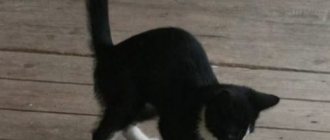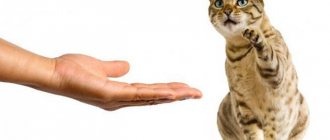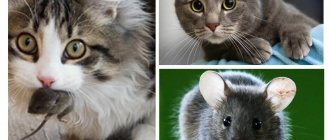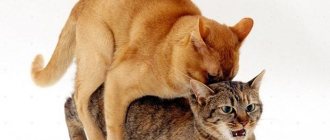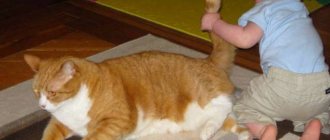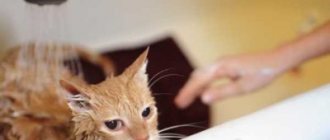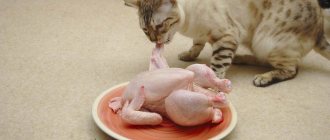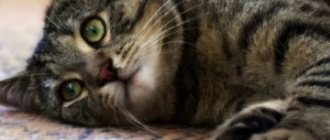We all know from childhood that the cat is the main enemy of the mouse. But in real life, not every mouse is ready to catch a mouse. Domesticated animals are often afraid of rodents and do not know what to do with them. And they have no desire to change their usual diet.
Each kitten acquires the skill of catching mice from its mother cat. If she taught him this vital activity, then in the future an adult animal will be able to catch rodents for food without any problems. But such a skill can only be imparted by homeless or village cats who themselves go hunting every day.
Cats have long helped humans in the fight against mice and rats, for which they were held in high esteem in Ancient Egypt and Rus'. It is believed that the ancestors of this animal themselves came to humans, after which they were domesticated, but to this day they have retained their independence.
A well-fed city cat is not inclined to catch, but the hunting instinct lives inside it. Therefore, under favorable circumstances, it may well become a “thunderstorm of mice.” Just before you start learning, there are a few things to consider.
Yard VS Thoroughbred
The hunting instinct is alive in every cat, regardless of the presence or absence of breed.
But in order to have the honor of being called the best hunter, the degree of expression of this instinct is important. In most cases, a purebred cat catches a mouse simply out of curiosity. She doesn’t try to eat her and doesn’t even always kill her: over the years of selection, breeders have managed to euthanize the cats’ natural inclinations, making these animals more suitable for life in a city apartment. So which cats are better at catching mice? It turns out that they are outbred? However, this is not always the case. Many owners deliberately breed completely domestic mongrel cats, but these cats also live in urban conditions, in apartments, and they see mice no more often than their blue-blooded brothers. If suddenly such a cat catches a rat, it plays with it for a long time, drags it back and forth, without trying to kill it with a precise bite to the back of the head, as real hunters do. And all because, in addition to a pronounced instinct, a cat requires skill. But how to teach a cat to catch mice?
This experiment was carried out back in the 1960s. Four cats and their offspring took part in it. The two cats were pedigree, and the cats for mating were selected accordingly. The other two are skilled hunters living on farms, mated with the same cats. Scientists made a substitution: outbred kittens were placed in purebred cats, and purebred babies were placed in farm cats. When the litters were not even three weeks old, the outbred cat caught a mouse and brought it to “her” kittens. The second yard dog did the same
The hunters taught the purebred kittens to handle their prey with caution and surgical precision. Outbred kittens raised by purebred “mothers” learned only to play, but not to kill - they were not given such an opportunity
As a result, it became obvious which cats are better at catching mice: those that were born and raised in certain conditions, with access to natural prey, raised by rat catchers and with small claws knowing why, in the opinion of hunting cats, nature created mice and other small animals. living creatures
This experience proved that, despite the importance of heredity, upbringing and the conditions for raising litter play a decisive role in the issue of catching rodents.
Therefore, when choosing a future thunderstorm of mice, you should rely on the conditions of keeping the kittens. Ask your neighbors about this question: there is almost certainly a cat living on one of the adjacent plots, whose owners annually adopt kittens born from the gulena
You can bring a rat catcher into a private home directly from the street - a kitten born in the basement already has the necessary skills at the age of three to five months. What breeds of cats catch mice? These are animals of natural proportions, raised in a nursery in a suburban area (with access to the street, and not living in enclosures). These include our Siberians, Russian Blues, Thais, Kuril Bobtails and overseas beauties - Maine Coons, Abyssinians, Bengals, Ocicats, European Shorthairs.
Heredity and upbringing
Numerous studies prove that a kitten's hunting abilities are influenced not only by heredity, but also by upbringing. If the baby had free access to prey, and his mother taught him to catch mice, then he will become a good hunter, regardless of breed or lack thereof. Of course, if you add to this the need to get your own food, your abilities will develop even better.
Good heredity
And yet heredity is very important in the formation of real mousecatchers. If all ancestors caught mice, then most likely this skill will pass on to kittens. But the most important role is played by the mother, she is the one who helps babies develop the hunting instinct, turning it into a skill. The mousetrap cat begins to train kittens from an early age, and they adopt all her experience by about 4-5 months. So before this age you should not take the baby away from its mother.
How to raise and teach a cat to catch mice?
The future mouse catcher's hunting skills need to be developed from early childhood. Usually the mother does this. It all starts with the cat catching a live mouse and bringing it to the kids. Later, the kittens begin to hunt on their own, first under the supervision of their mother, then alone.
But you can try to teach your kitten to catch mice yourself. To do this, use active games, special toys, or another effective option - walks, during which the kitten can catch frogs, beetles or butterflies. Every time the baby catches prey, he should be praised.
It is very important to remember that you cannot force a cat to catch mice by starving it. The animal will weaken, become lethargic and will no longer have the time to hunt. There is a high probability that the cat will begin to climb through garbage dumps in search of food. But it is important not to overfeed the cat so that he remains active.
Production
If a cat has the makings, and the training has borne fruit, then pretty soon you can see your pet eating its first mouse.
Why do cats bring caught mice to their owners?
An interesting point is that a cat does not always eat caught mice. For many mustachios, the hunting process is much more important and interesting, and they prefer to eat their usual food. Quite often, strangled or slightly chewed rodents end up on the windowsill, on the threshold, or even by the bed of their beloved owners. There are several explanations for the fact that the cat did not eat the mouse, but brought it to the person:
- Many cats perceive people as clumsy creatures who lack even the most necessary skills. By bringing us prey, the pet shows concern so that its human does not die of hunger.
- The cat is proud of itself, hopes for recognition and praise, or wants to please its owner.
- The animal stores food for the future and believes that food will be safer in the house.
In any case, the appearance of a dead mouse in the house should be taken calmly, and the cat should be praised and thanked. You can throw away a gift only when the pet does not see it, otherwise resentment on his part cannot be avoided.
Who is better at catching mice - a cat or a cat?
Both male and female cats catch and eat mice. But females are considered the best hunters. They have a more developed hunting instinct, while males are more focused on finding a partner and procreation. A cat needs to provide food not only for itself, but also for its offspring.
A fairly popular question is which cats are better at catching mice - neutered or not. Castration does not affect the hunting instinct in any way, but as practice shows, it often affects the animal’s lifestyle. The cat becomes lazy and avoids any active actions, which naturally negatively affects his hunting abilities. Interestingly, the habits of a sterilized female usually do not change.
Other breeds
As a hunter for a private home, you can purchase the following breed of cats:
European Shorthair
Smart, active and inquisitive pets, distinguished by courage and bravery. The European Shorthair cat adapts to any weather conditions and is distinguished by its affectionate behavior.
In the fight against rodents, animals have proven themselves to be ruthless killers. European tabby. The color of the animal is similar to that of a tiger. Tabbies are distinguished by their strong structure and muscularity, have a strong, large head, sharp teeth and claws. The hunting instinct is inherent from birth, so they grow up to be excellent mousecatchers. Turkish Angora. Cats of this breed have snow-white fur and blue eyes. Despite its defenseless appearance, the Turkish Angora tends to live in the yard and lead an active life. Thanks to fearlessness and curiosity, the pet effectively catches mice.
Cat breed
The debate about which cat breeds are better at catching mice continues to this day. In fact, each of them has a hunting instinct, even the most pampered Persian beauty. The simple fact is that some animals manage to train their skill, while others, due to lack of practice, have long lost it. Thus, it is believed that Siamese, Bengal and Siberian cats, British Shorthairs and Maine Coons make good mousecatchers. But still, not every owner will decide on such experiments, because purebred animals require special care and feeding.
By what external signs can one identify a future mousetrap?
It is believed that a cat that can successfully catch mice must look the part. What signs can be used to determine which kitten will be an excellent rodent exterminator?
Signs of a mousecatcher:
- long mustache;
- wild color - black, red or gray, two or three colors, with faint stripes and spots to blend with nature and remain invisible to its prey;
- short hair – long and thick guard hair when wet acquires an unpleasant odor, which can scare away the rodent;
- large ears and triangular head;
- large paws.
They tried to choose the best rat catcher using these signs several decades ago. In reality, there are no perfect rat hunters. Every cat has a hunting instinct from birth, but not all representatives of the feline family realize it with equal success.
Before you take a kitten into your home to catch mice, you should ask whether its mother was a good hunter. When raising their cubs, cats pass on their skills to them, including in catching rodents.
If the pet was taken from the street, it is highly likely that its hunting skills will be well developed. In purebred pets, the instinct is dulled, especially if several generations of animals have lived in apartments and do not even know what a mouse or rat looks like.
Is it possible to teach a cat to hunt if she doesn't show much desire to catch mice? In order for the animal’s natural instincts to awaken, it is necessary to let the pet feel a slight feeling of hunger. A cat should not be completely deprived of food - this is cruel and fraught with health problems. You just need to reduce the portion size: malnutrition will awaken the instinct in your pet. After the first successful hunt, it is advisable to reward the animal.
You need to teach your pet to hunt from childhood. There is no point in training an adult castrated cat. The purpose of its existence is food and sleep, such animals become lazy and quickly gain excess weight, and it becomes more and more difficult for them to run every year. But you can and should awaken a kitten’s interest in hunting. To do this, catch the mouse using a mousetrap and let your child play with it while it is still alive.
To activate the kitten's hunting instinct, you should play with it more often using a laser pointer or special toys. If your pet tirelessly chases them, he will become a professional in catching mice.
Why does a cat find no interest in hunting?
The cat, although it is a domestic animal, remains a predator by nature. She must get her food by hunting, for example, by catching mice. However, any instinct must be reinforced in practice, otherwise it fades. If for several generations an animal has not been required to perform this type of activity, it simply loses its natural skills. When a cat's day consists of sleep, balanced and tasty meals, and slow walking around the apartment, she has no need to go hunting. Thus, the first reason is elementary laziness, which develops quickly and for a long time in cats. The look of such animals is slow and calm, their movements are smooth and graceful, and their paws are not strong.
Since the time the industry began to offer healthy cat food, the need to feed live food has disappeared. All nutritional components come from an artificial product with a balanced composition, including separately for kittens. Feed contains vitamins and microelements, biologically active substances, proteins, fats, carbohydrates. This is often enough for the full functioning of the body and a decent appearance. This is reason number two.
Thirdly, the artificial breeding of prestigious breeds led to genetic mutations, during which the hunting gene gradually weakened. Therefore, breeds bred through selective breeding almost never know how to catch mice.
The fourth reason, which many put in first place, is the basic lack of hunger. A well-fed animal is content with its condition and does not see the need to run after mice. It is difficult to stir him up, much less make him run after rodents.
Character and behavior of lop-eared animals
The Scotsman is a purebred cat that is distinguished by its kind disposition. Distinctive behavioral traits:
- communication skills and sociability;
- love for children;
- gaiety;
- easy to educate with the right and friendly approach;
- actually cannot be trained;
- playful;
- not mischievous;
- they quickly forget bad things and do not take revenge.
Scottish Folds are an ideal option when there are other animals and children in the house. Such kittens are real aristocrats with their mannerisms and waywardness. Their restiveness and capriciousness are often observed. If the Scots want something, they will definitely achieve it. An adventurous breed with a curiosity for the unknown. When new people appear on their territory, Scottish cats are not very friendly, but then they begin to communicate. Scots love to play, but are not particularly happy with cuddling and cuddling.
How to teach a cat to catch mice
In order for a cat to catch a mouse, it is necessary to initially raise the kitten correctly. At birth they do not have the necessary skill. The mother cat does the upbringing. To develop a hunting character in your pet, you need to train it from an early age.
Some people mistakenly believe that if you don't feed the rat catcher cat before hunting, the cats will catch rats faster and in greater numbers. In fact, the pet needs food to generate energy for hunting.
A hungry cat will have a more difficult time completing the task. If you want a happy cat with a mouse in its teeth to not be a rare occurrence for you, then you shouldn’t starve it.
How to make a cat catch mice: do not overfeed the rat catcher's cat, do not make the rat catcher's cat starve. In addition, you need to reward your pet if it catches a mouse or rat.
Play with your cat using live bait. Catch rodents in mousetraps and give them to your cat. Do not use poison for catching, you can harm the health of your pet.
What to do if the cat does not catch mice:
- Understand the reason for this behavior. Perhaps your pet is sick with something. Visit your veterinarian.
- Feed properly in small portions 5-6 times a day.
- Perhaps sterilized animals have an incorrect diet, create a dietary menu.
It is quite difficult to train a kitten to catch mice, so the mother takes responsibility for raising the kitten. At what age do kittens begin to catch mice? The ideal period for this is 4-5 months.
Keep in mind that your pet needs to be vaccinated before engaging in rodent control. The main one is the rabies vaccination. If your pet is bitten by a rat, immediately take it to the veterinarian for an examination.
At what age does a kitten begin to catch mice on its own?
Let’s not keep the intrigue going and answer right away: a kitten becomes a hunter at three months.
Now let’s tell you in a little more detail how, who and when teaches kittens to hunt.
We got our own cats not only for the sake of their beauty and cuteness. We were plagued by mice, gnawing everything they could in the house and garden. With the advent of cats, the problem was solved.
Now we have two cats and a male cat living with us. They grew from kittens into adult hunters before our eyes, and this always happened in three stages and according to the same pattern:
1.
When the kittens are
a month
, the cat catches and brings into the house the first mouse for her babies. The kittens are still too tiny to play with her, so the first acquaintance comes down to sniffing, and sometimes they can timidly touch her with their paw.
2.
At
two months,
the mother cat brings another mouse, and already then the grown kittens begin to excitedly chase after it, play and take prey from each other.
3.
When the kitten turns
three months
, he brings his first independent hunting trophy into the house.
Today, kitten Kazimir caught his first cockchafer-sized mouse in the garden and proudly laid it at our feet during breakfast.
Then he tormented his prey for a long time and recklessly. A worthy heir to Mitrich, the founder of our cat pride, is growing up.
By the way, we noticed that as cats age, they become less inclined to hunt mice. The best hunters are teenagers under one year old. In the photo below you can see how the five-month-old Turtle (Kazimir’s mother) is chasing a mouse around the kitchen, and her parents - red-haired Mitrich and Marusya - lazily watch her, without interfering in the game.
Source
Who is the best hunter - a cat or a cat?
Who is better at catching rodents - a male or a female? It is believed that the best rat hunters come from stray cats. Maternal instinct forces the female to hunt, and the cat hones her skills to perfection.
Males are not as active as cats. Their main task is procreation; for this, the cat needs to interest and attract the female. However, a cat deprived of food, forced to rely only on itself to solve the “food issue,” is guided by instinct and becomes an excellent hunter.
Cats hunt mice and rats most actively about once a quarter, before the approach of estrus. Consequently, about 3-4 times a year, a pet can clear a house or apartment of uninvited guests. The best candidate for the position of mouser is considered to be a cat.
Recommendations
A hunting cat spends a lot of time outdoors, in contact with other animals, which increases the likelihood of infection and the development of diseases. To protect your pet from diseases, you need to remember the following rules:
- the cat must be periodically vaccinated against potential diseases;
- the pet needs to be fully fed and fortified with vitamin supplements, which will strengthen the immune system;
- every 5 months, clean your pet of worms for the purpose of prevention;
- the animal needs to buy a flea collar that prevents the spread of parasites;
- in early spring, before a walk, it is recommended to treat your pet’s fur with protective sprays, since in May the likelihood of insect attacks increases.
For preventative purposes, you can take your cat to the veterinarian for examination once every six months.
How does castration affect the hunting instinct?
Owners of apartments in urban high-rise buildings are not particularly concerned about the loss of hunting skills in their cat after sterilization. But for owners of private houses this topic is extremely relevant. How does the castration or sterilization procedure affect an animal’s ability to kill rodents?
The decision to neuter a cat will not greatly affect its hunting instincts. Cats before and after castration exterminate rats and mice in the territory entrusted to them with equal eagerness and skill. The exception is castrati who are overweight, which appears due to a sedentary lifestyle and too high-calorie diet. It is difficult for such pets to move, and their hunting skills are gradually reduced to zero.
Since the ability to hunt in cats is inherent at the level of instinct, it is difficult to influence it by sterilization. After the procedure, the animal may become less active and mobile, go out hunting less often, but this will not make the ability to track and catch a mouse disappear.
While cats often become fat and lazy after castration, spayed females, on the contrary, show more interest in hunting. Many cat owners claim that after their pet has become infertile, it goes hunting more often and brings its owners the trophies it catches. In addition, having lost interest in the opposite sex and not spending time and energy on bearing and feeding offspring, the cat directs all its energy to satisfying the hunting instinct.
In general, a tendency towards hunting and active games can be identified in an animal even in childhood. If, as a kitten, the pet is not distinguished by curiosity, nimbleness and activity, it is unlikely that in adulthood, especially after castration, it will be drawn to adventures. Typically, castrated cats become more obedient, calm and balanced.
How to let your cat know what is expected of him
If it is important for the owner for the cat to fulfill its direct natural purpose, it is worth trying to teach it to be a hunter.
Advice from experienced people contains different sequences of actions. The first ones recommend starting with developing a feeling of hunger. By keeping the animal on a “starvation diet” for some time, you can provoke it to go in search of food on its own.
Other experts recommend starting with developing the skills of agility, swiftness, attentiveness and tenacity. When a cat feels strong, she will become interested and want to show it in hunting. For training, you can use an artificial mouse, which you can quietly pull on a string, teasing and captivating the future hunter. You can pick up a live mouse that is not the first freshness, for example, the one that the neighbor’s cat caught.
According to others, the instinct to catch mice should be developed through stimulation. For each mouse caught, the animal should receive some kind of reward (a treat, a favorite pastime, a toy, etc.). Then he will have a natural interest in a process that promises new pleasures.
Finally, the fifth group of “cat experts” is of the opinion that the cat is an extremely intelligent animal. It always understands what is expected of it, but it doesn’t always want to do it. If you praise her, please her in every possible way, celebrate all her good deeds, but at the same time make it clear what is expected of her, she will definitely thank her for her kind attitude with caught living creatures.
There is an opinion that it is easier for cats to develop the instinct to catch mice than for cats. This is due to the inherent nature of the female individual’s responsibility for caring for offspring. The need to feed the kitten will help the cat understand how to obtain natural food.
Cats squabble, mice are welcome (proverb)
If there is already a cat living in the house, but it has not succeeded in catching rodents, the second pet should be of the opposite sex. One of the pets will have to be castrated, otherwise constant “weddings” are inevitable, knocking the hunter out of her “schedule”. There has been a lot of research into whether neutered cats catch mice. It has been proven that sexual desire only hinders a cat, and does not spur it on. A sterile cat, having forgotten about “partying”, devotes more time to games and hunting, and therefore is more successful. A castrated cat will not hunt less if he enjoyed this activity before the procedure. But if all his thoughts were occupied only with the search for partners, castration is unlikely to awaken in him a passion for hunting, although this also happens.
Two cats are the worst option: they will sort things out, forgetting about the mice that are getting bolder every day. Two cats can coexist peacefully if there is enough space and love in the house for both. Perhaps a more successful hunter will even become an example and be able to interest a lazier cat.
Gender of the animal
It is believed that females are more prone to catching mice than males. The fact is that cats have a highly developed sexual instinct, which sometimes prevents them from fulfilling their hunting duties. But the cat, on the contrary, is more inclined to hunt, because She has a nature to feed her offspring in the future. Of course, during estrus, the pet is unlikely to think about mice, but this period does not last long, and soon the cat is ready for exploits again.
In general, animals of both sexes will be able to catch mice, it’s just that males will do it more for fun, and females, even sterilized, will obey the survival instinct.
Main breeds of rat catchers
Independent hunters are representatives of the Russian Blue breed. They become attached to only one owner, whom they are ready to protect from rodents. Athletic athletes - Chartreux cats - have a beautiful athletic physique, which helps in catching rats and mice.
Maine Coon
This ratcatcher cat is the largest breed; it is an intelligent and selective animal - a good hunter. The Maine Coon reacts with lightning speed to a rodent, and its powerful body and dexterous movements leave no chance for rats and mice. At the same time, he is a sweet and gentle creature who will purr with pleasure in his owner’s ear.
Siberian
The Siberian cat rarely becomes attached to humans, perhaps it has the “wild” blood of its ancestors. This balanced and powerful animal is considered the best rat hunter. Freedom is very important for an obstinate pet; the cat wants to walk outside from time to time. The Siberian cat is capable of developing great speed in running and jumping well. In addition, the animal has an excellent reaction.
European
The cat was common in ancient Rome. She copes well with the duties of a rat catcher. Each representative of this breed is an individual. The animal has a silver marbled or gray color.
Kurilian Bobtail
The animal was brought to us from the Kuril Islands. By their nature, the fluffies of this breed are similar to dogs. The little kitten quickly becomes attached to its owner and tries to take care of him.
The Kurilian Bobtail has a small tail. The cat has elongated and powerful hind limbs, which allow him to jump and develop great speed while running. The Bobtail can cope with any rat's home.
Siamese
Humans have nothing to do with the breeding of this breed. Siamese cats are fast and graceful. They have a very well developed hunting instinct.
How to make a cat catch a mouse
Only then will you be able to sleep peacefully.
1. Getting to know the subject of the hunt
Borrow a mouse from a neighbor. Of course, you can catch the mouse yourself, but it will be easier if a neighbor does it. By releasing the mouse in front of the cat's nose, get the cat interested. Let the cat feel that the mouse is not a scary animal. The main goal of the exercise is to set up the cat’s target recognition systems and its (target) tracking.
2. Dummy mouse
Since a live mouse is a very nimble and unpredictable creature that is drawn to a mink, it will be difficult to train a young cat on a live mouse. You're not eager to pick it out from under the sofa every five minutes, are you? Therefore, to train a cat's hunting skills, you can use a gray and fluffy dummy mouse tied to a very thin thread or fishing line.
3. Learning basic hunting movements
Study the habits and running movements of a mouse using the encyclopedia. Place the cat in the center of the room and, by manipulating the speed and course of the mouse, achieve stable conditioned reflexes of the cat to the mouse. Remember that the main stages of hunting are: lying in wait for a target, sneaking up and attacking from different positions. Your task is made easier by the fact that a cat that is not completely well-fed reacts well to a small moving object, such as a bow, lace or a ball of wool.
4. Steeplechase and hurdles
Since a natural mouse does not express a desire to run straight, evenly and in open areas, but expresses a desire to run in hard-to-reach places (through holes, under a sofa, and a closet), it is necessary to train the cat to quickly force through any obstacles. To do this, tie a piece of delicious sausage to a string and pull a piece of this sausage over the obstacles. Don’t forget to periodically give a piece of sausage to your cat to eat. And don’t lure your cat to places where you can’t get him out manually if he gets stuck.
5. Pursuit routes
Practice shows that hunting is most successful when the cat moves along familiar places and routes. In this case, the running speed and the speed of overcoming obstacles will be maximum. Therefore, you should calculate all the routes along which the mouse will move (and, if necessary, lay them yourself), and, using a dummy, do several training marches.
6. Working by bearing
Because your cat has two ears, he can turn his head to determine where a sound is coming from (this is called “binocular hearing”). So that the cat can confidently distinguish the rustling and squeaking of a mouse among other noises, place sources of mouse noise in different nooks and crannies of the room. By turning them on in random order, get the cat to have a stable bearing of the suspicious sound.
7. General physical training
Don't let the cat lie around and sleep! Develop his running skills and long and high jumping skills (but remember that cats, unfortunately, do not pole vault). Provide your cat with a place where he can sharpen his claws and teeth.
8. Mouse in paws
If your cat has caught a mouse, but doesn’t know what to do with it, teach him to hook with his left and right paws. This will give the mouse hunt the finishing touch and logical completion.
Happy hunting to your cat!
How to teach a cat to catch mice
Greenpeace people don't read it - a heart attack is guaranteed.
That was a long time ago. There are rats in our barn. The grandfather went to a friend whose cat had given birth and took a kitten to solve this problem. The future super rat catcher was named Vasily.
The kitten grew up, ate cottage cheese, drank home-made milk, caught flies at the window, but did not want to do what it was taken for - at least catch mice, not to mention rats. The mice caught in the mousetrap did not evoke any predatory instincts in the cat.
It was in the 50s, and my grandfather was a veteran of the Great Patriotic War and a rather stern man. When Vasya reached normal mouse-catching age, but showed no desire to do what he was taken for, my grandfather, unnoticed by my grandmother, locked the cat in the barn for the night, and according to available intelligence data there were, to put it mildly, a lot of rats there.
When he went out to smoke in the morning, the grandfather was slightly surprised - the beaten and crazy Vasily was sitting at the threshold of the house, with the tip of his ear chewed off, a broken tail, barely alive but alive! He didn’t even have the strength to meow in order to give a signal that I was a jerk. In order to avoid the inevitable ending of being eaten by barn rats, he managed to knock out one of the small glass windows! Granny gave a prescription to grandfather and began treating the cat. I don’t know the details of the treatment, but the cat recovered quickly enough - thank God the paws are intact and the stomach is not ripped open.
It is better to feed one cat than a hundred mice (proverb)
And not only to feed, but also to protect from possible dangers. The owner of a rat-catching cat should not skimp on vaccinations, deworming and other preventive measures
Treatment for fleas and worms - all this is extremely important, because a cat that catches wild rodents is daily exposed to the risk of becoming infected with parasites and viruses. “Apartment” mice and rats can be poisoned by slow-acting arsenic and other poisons: eating such prey leads to serious poisoning and sometimes to the death of the pet
Therefore, you can only allow a cat to eat mice if you live in the countryside, and if you know for sure that your neighbors do not use pesticides to control rodents.
Peekaboo
And which cats are better at catching rats than others, based not on their breed, but on their appearance? It is believed that these are short-haired animals: in damp weather, long hair smells stronger, scaring away potential prey. In addition, the fur coat must be appropriately colored: dim stripes and spots are welcome, the so-called “wild” color, which helps the hunter to blend in with the terrain. If there is no pattern on the fur coat, calm, soft colors are preferable: a white cat has difficulty catching a mouse, but a red, gray or black one can hide more easily, using the features of the landscape. And, on the advice of our grandparents, choose the most whiskered kitten: the longer the whiskers, the more successful the hunt.
Relationship with the owner
A true Briton is smug and self-sufficient, and views his owners as breadwinners. It is not without reason that this breed is considered suitable for business people. They don't like to sit on their hands and can't stand noisy companies at all.
After a long day of work, the pet will greet the person reverently and tenderly, and will rub against the legs. They don’t like it when the owner stays late somewhere and doesn’t come home from work on time.
If there is a child in the family, you should not have a Briton for his entertainment. Representatives of this breed are very patient with children, but they will not allow themselves to be made into toys. They will hide and run away.
It is very rare for a straight-eared Briton to be “tame.” He doesn't often ask to be held and petted. However, when he needs to climb onto his owner’s lap, he will follow along until he achieves his goal.
Attitude towards other animals
If you already have an animal in the house and you decide to get a British one, then it is very difficult to guess how the relationship will develop. Representatives of this breed have a rather capricious character, everything is very individual.
There are no particular problems with other pets. Relationships can be very good if a British kitten and another cat or dog are taken into the house at the same time. They are still getting used to each other as babies.
In the case when an adult is taken into the house, everything depends on how the other animal will treat the representative of the British breed. They really don't like being bothered
It doesn’t matter what kind of pet is next to them in the same apartment. The main thing to maintain calm is to simply not bully or touch them
Britons usually get along easily with other animals.
“The incompetent leader must be fed”
The predatory nature of cats is not in doubt, as is their independent nature. But the judgment that these animals always live only alone is not entirely correct. Not to mention the fact that “relatives” of cats, such as lions, live in prides. Something similar can be observed in nurseries or houses where several cats live at once. Certain relationships are established between animals when they live together for a long time.
Among them are the “quiet ones” who like to sit by the window or in the corner, those who follow the leader, and, well, the “leaders” themselves. Thus, cats also have a kind of pride. A cat that lives among people perceives the human family as a kind of pride, in which roles are also distributed in a certain way. She identifies for herself both the leader and those who are lower on the steps of the family hierarchy, and treats them accordingly. Most often, she does this by focusing on the timbre of the person’s voice and emotions.
How to raise a hunter
Some people wonder why a pet, even of the “right” breed, does not catch rodents. For a kitten to become a rat catcher, it must be raised properly
It is important that his mother herself is a rat catcher and instills in the baby the necessary skills
If you adhere to certain rules, you will definitely raise a good hunter:
- Encourage the hunting instinct in your baby - praise the animal if it has caught prey.
- Don't starve the animal. Otherwise, the cat will run away or start stealing food from neighbors, collecting in trash cans, and not catching the rat.
- Your pet should be fed in small portions several times a day. The bowl of food should not be left standing all the time.
- The rat catcher should be vaccinated against rabies. If a rat has injured an animal, contact a veterinarian immediately.
How to let your cat know what is expected of him
If it is important for the owner for the cat to fulfill its direct natural purpose, it is worth trying to teach it to be a hunter.
Advice from experienced people contains different sequences of actions. The first ones recommend starting with developing a feeling of hunger. By keeping the animal on a “starvation diet” for some time, you can provoke it to go in search of food on its own.
Other experts recommend starting with developing the skills of agility, swiftness, attentiveness and tenacity. When a cat feels strong, she will become interested and want to show it in hunting. For training, you can use an artificial mouse, which you can quietly pull on a string, teasing and captivating the future hunter. You can pick up a live mouse that is not the first freshness, for example, the one that the neighbor’s cat caught.
According to others, the instinct to catch mice should be developed through stimulation. For each mouse caught, the animal should receive some kind of reward (a treat, a favorite pastime, a toy, etc.). Then he will have a natural interest in a process that promises new pleasures.
Suitable breeds
The best mousecatchers are native cat breeds that appeared naturally and have not undergone significant transformation. Compared to artificially bred ones, hunting skills in such breeds have been developed over centuries, which has given the corresponding result.
Maine Coon
Maine Coon
Cats of the Maine Coon breed are the best hunters of mice and rats. Maine Coons are distinguished by their large size and strength, which does not prevent them from gracefully jumping and chasing prey in hard-to-reach places. Maine Coons are gambling animals. A cat can chase a rat for hours, ignoring heat, cold, and rain. Thanks to its thick coat, the animal feels comfortable in the cold and can spend a long time outdoors. Large body sizes make it possible to destroy large rodents, which repel smaller rat catchers. Maine Coons prefer to spend time in the yard; country life is an ideal option for them.
Russian blue
Russian blue
Due to its compact size and aristocratic appearance, village house owners doubt the hunting skills of the Russian Blue cat. The lack of heavy weight is compensated by a quick reaction and the ability to move quietly around the yard. The Russian Blue cat tracks rodents of any size, which serves as the main entertainment for the pet. The cat's movements are graceful and precise, the speed of movement is amazing. The owners of Russian blue cats confirm that they hear any rustle and leave no chance for the mice to survive.
Siberian
Siberian
The skill of catching mice among Siberians has been confirmed by more than one generation. The pet is large in size and has thick fur, which allows it to pursue prey in any weather conditions, moving silently. The role of sound insulation is performed by fluffy pads on the paws. Siberian cats move in jerks and make long jumps, which allows them to cope with the prey. Since Siberians are not attached to their owner and home, pets spend most of their time outside, ambushing rodents. When the Siberian cat is busy tracking down prey, it ignores the call of a person and the feeling of hunger, plunging into the hunt. It is recommended to get a breed for people living in the northern regions.
Kurilian Bobtail
Kurilian Bobtail
They are distinguished by their attachment to the owner. Kurilian bobtails have a canine disposition and are ready to protect their owner from all threats and misfortunes. According to the cat, the main danger to humans is the mouse, so the pet devotes all its energy to tracking down and eliminating the rodent. Kurilian bobtails have powerful hind legs, allowing them to develop great speed and make long jumps. The animal moves from place to place with ease and is capable of destroying broods of mice. Thanks to its determination and courage, the Kurilian Bobtail is not afraid to get into a fight even with a medium-sized dog, so the owner does not have to worry about the safety of the yard. The cat will guard and defend the territory of the house until the end.
Nibelung
Nibelung
A rare breed of domestic cats with a difficult character. Nibulungs are proud and freedom-loving. The animal will not let a person near until it is convinced of his kindness and reliability. English origin and royal appearance do not prevent the Nibelungs from destroying the mice that have settled in the house. Due to their thick, long fur, Nibelungs require grooming, otherwise the pet will develop voluminous mats.
Cymric
Cymric
In appearance they resemble yard cats and have a short tail like a bobtail. It is believed that an elongated tail makes hunting easier, but practice shows the opposite. Thanks to the original structure of the body, the Cymrik is perfectly oriented in space and moves gracefully. Strong paws and sharp claws make the animal a successful rat catcher. Cats have a playful disposition and are active; they love to spend time outside, hunting for rodents. To stay fit and healthy, the animal needs long walks and fresh air. It is recommended to keep them in a private house in an open area.
British Shorthair
British Shorthair
Because of their cute faces and plush fur, Britons are considered sissies and couch potatoes, but these purebred animals make the list of the best rat catchers. The British have a well-developed hunting instinct and have the necessary inclinations. To please the owner, to receive rewards and praise, the animal is able to catch and bring prey in its teeth. Since British Shorthairs are compact in size (weighing rarely more than 5 kg), they often hunt mice and young rats. They rarely enter into battle with large individuals.
Stages of training
Having decided to train, you need to have patience and endurance, prepare the necessary details, and also allocate a time and place where no one will interfere. The stages are as follows:
- Prepare a dummy mouse. It is desirable that it be soft, mobile, accompanied by sound. By launching it, the goal is to arouse a keen interest in the cat to catch up, grab it and hold it tightly with its claws. Some cats, tempted by such actions, begin to catch real mice, but do not eat them. They are perceived by them as a positive result of their hunt or just a toy. But it is not important. The main thing is to develop a taste for hunting.
- Develop a training plan for developing habits and running skills: place the cat in the center of the room, using movements of a tethered mouse of varying amplitude and speed to try to arouse its keen interest. First, the cat’s eyes “light up”, it focuses its gaze on the target, then freezes and takes aim. The final stage – the jump – is sharp and rapid. The exercise is repeated several times with the bait placed from different sides and at different distances. The more the cat fails, the more angry she will be and try to achieve her goal.
- If the previous stage begins to have results, the task should be complicated. The cat must understand that the mouse does not run in a straight line. It moves chaotically, turning sharply and changing its trajectory. This is what needs to be staged, for which purpose, put obstacles and barriers along the route, and arrange hard-to-reach places. On the obstacles themselves, you can increase the animal's interest by tying a piece of her favorite treat to a thread. Please note: in order to “help” the cat catch the mouse, you need to train in the place where it is supposed to move. Movement along familiar routes is always faster, faster, and more effective.
- Sound stimulation training. During training, you can develop the instinct of hunting by sound. By downloading a live mouse squeak on the Internet and playing it in different corners of the room, you need to make the cat perceive this sound as a signal to hunt. When he understands this, it is necessary to encourage the hunter. This type of training is called bearing.
- An important condition for successful training is the general physical fitness of the cat. Laziness should not be allowed to develop in him. Let him move more, jump for food or a toy, sharpen his claws and teeth. It should not be overfed and brought to excess weight. Apart from problems with digestion and the musculoskeletal system, this will not cause anything.
The described training will definitely give a positive result if carried out regularly, under the same conditions, with similar words. At this moment there is no need to scold the animal. Perhaps the situation is so advanced that it simply does not understand what they want from it. Then it will take more effort. If the owner’s patience runs out before the ward learns to catch, the rodents in the house will have to be caught with a mousetrap.
The cat sleeps, but sees all the mice (proverb)
Because of the hunter’s attachment to the house, many owners are faced with the problem: “Why do cats bring mice to the doorstep, to the owner’s bed, to the kitchen?” Finding a dead or half-dead rodent is not very pleasant. But animal psychologists recommend treating this phenomenon calmly, without scolding the cat or throwing away this unique gift in front of her eyes. If your pet brought a mouse and defiantly laid it on the floor at your feet, this speaks of strong affection and love: “Here, eat. You’re clumsy, strange, you don’t have a tail - you’ll never be able to catch it yourself.”
There are other reasons why cats bring mice. One of them is banal practicality: “What if tomorrow you won’t be able to catch prey?” The second is the desire to play with the mouse later, after completing more important tasks known to one cat. And the third is uncertainty: “I’ll play here, otherwise there are plenty of other cats on the street, they’ll take more of them.” In any case, the more acutely the owner reacts to this behavior, the more often the cat will bring prey into the house. It’s better to quietly throw the rodent out or take it outside the threshold and defiantly put it somewhere nearby: “Store it here, no one will touch it!”
Do they catch mice?
Representatives of the breed do not have hunter instincts, and therefore, if they catch a mouse, it is only for play.
Choosing a fold-eared cat to get rid of rodents is not the best idea. These are not Thai hunter cats, which are focused on finding prey and destroying it. The Scottish feline can catch a small mouse, but he will be scared of a rat and hide in a corner
It is worth paying attention to the individual character traits of the animal. A pet torpedo will be interested in hunting and will look for an opportunity to frolic; a lout will not be interested in such an activity
A domestic purebred cat can easily be poisoned by a caught mouse, since he is accustomed and accustomed to home-cooked food.
Which ones are caught?
The role of the best mouse hunter was taken over by outbred cats, who were born on the street and raised by their mother, who hunted to feed her offspring. It is in their upbringing that this is the only way to get food. When choosing a cat solely for the function of catching mice, people focus on aggressive breeds (British, Siamese, Maine Coons). According to numerous testimonies from owners, British cats are capable of catching and destroying even a rat.
Why do cats bring caught mice to their owners?
Animal rights activist, coordinator of the Novokuznetsk Society for the Protection of Homeless Animals “Cat and Dog” Vadim Raskin:
“Cats are often attributed a human type of thinking. But a cat is an animal, a predator, once tamed and domesticated by man. This is what we must proceed from.
There is a common misconception that cats do not live in packs, that cats are solitary animals. This is wrong. While helping homeless animals, I have often seen cat prides with a strict organization and their own hierarchy. As for domestic cats, we call them and consider them domestic cats. The cats themselves have no idea about this; they perceive the world around them as a unique world of wild nature, and the family in which they live as a pride. Moreover, from the cat’s point of view, the owner is not always the head of the pride
